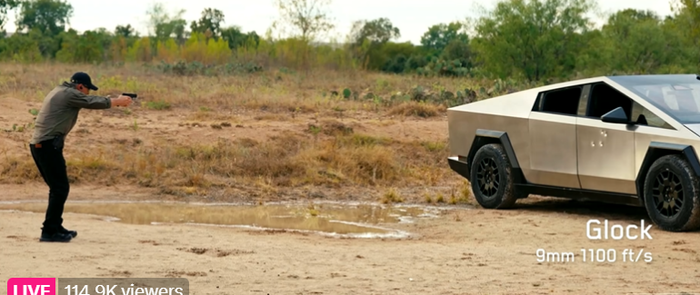Tesla Launches Cybertruck Into Sea of Pessimism
Tesla Motors CEO Elon Musk delivers the first Cybertrucks to paying customers, emphasizing toughness, performance and utility.

Tesla has delivered its first Cybertruck, four years after its polarizing reveal.
Despite Tesla CEO Elon Musk’s goal of ramping up to building 250,000 of the trucks by 2025, forecasts are awash with skepticism that the comic-book-styled truck will reach a quarter-million sales over the life of the truck.
That said, Musk gave a lively presentation as he prepared to deliver the first production trucks to buyers who had come to Austin, TX, to take delivery of their vehicles from the factory.
“It (Cybertruck) can not only beat a Porsche 911 on the track, but it can also tow a 911 faster than the 911 can drive itself,” Musk proclaims following a video in which a Cybertruck beat the Porsche sports car on a track.
In another gonzo demonstration, a man with a machine gun fired bullets into the side panels of the Cybertruck (pictured, below), with none passing through the metal. “At Tesla, we have the finest in apocalypse technology,” Musk comments glibly. “If you are in an argument with another car, you will win.”
tesla2.png
Addressing one of the biggest criticisms of the Cybertruck design – how useful is it? – Tesla showed video of the truck outpulling a Ford F-350 diesel truck, as well as comparable models from Chevrolet and Ram and Rivian. Video also showed the bed being filled with dirt, as well as the truck towing construction equipment and having 4'x8' sheets of plywood loaded in.
Some of the technical specs revealed at the event: the truck debuts with steer-by-wire; 0-60 mph (97 km/h) time is 2.6 seconds; it uses a 48V battery for the ancillary electrical systems, which allows for 70% less wiring in the car, says Musk; turning radius is smaller than a Tesla Model S; 17-in. (432-mm) ground clearance; 35-in. all-terrain tires.
The rear-wheel-drive Cybertruck will start at $49,890, with a 250-mile (402-km) range, but won’t be available until 2025. The all-wheel-drive version will start at $68,890, with 340 miles (547 km) of range, 600-hp propulsion system, 7,435 lb.-ft. (10,081 Nm) of torque and 11,000 lbs. (4,990 kg) of towing capacity. The Cyberbeast, available in 2024, starts at $96,390, with a 320-mile (515-km) range, 2.6-second 0-60 time, 130-mph (209 km/h) top speed, 11,000-lb. (4,990-kg) towing capacity, 845 hp and 10,296 lb.-ft. (13,969 Nm) of torque.
Few critics or supporters of Tesla and the Cybertruck have doubted whether the company could manufacture a truck that could outperform its rivals in tests shown on video.
The questions are: How many buyers want the comic-book design of the truck; how reliable will it be in a product segment with incredibly demanding customers?; how many trucks per year can the factory manufacture and maintain acceptable fit and finish?
Industry experts have questioned Musk’s design and the Cybertruck's manufacturability. Indeed, Musk says the outer skin of the truck is made of a stainless alloy that required the company to develop a proprietary process to shape the panels. “This metal would break (conventional) stamping machines,” says Musk, of the material that won’t require painting and won’t corrode.
At the event, livestreamed to about 113,000 viewers on Musk-owned social media platform X, formerly known as Twitter, buyers came up to Musk and he ushered them into their new trucks before they drove them away from the factory.
Author Walter Isaacson, in his recently published biography “Elon Musk,” writes that Musk dismissed an army of naysayers about going ahead with the Cybertruck design because of the difficulty and cost of manufacturing, many on his own management team. He pushed back on all of them, insisting “I want it to look like the future.”
Usually, Wall Street analysts are bullish on a stock when a long-anticipated product like Cybertruck finally is ready for delivery. Not so this time. “Canceling Cybertruck would probably be positive for shares,” Jefferies analyst Philippe Houchois wrote last week. "With 2024 already a lost year for growth, it would help Tesla refocus on an edge that was built on simplicity, scale and speed.”
The pickup segment is like no other in the U.S., and it has eaten up other more-established automakers than Tesla. Toyota, which once envisioned 250,000 Tundra fullsize pickups a year, has never topped more than 197,000 (its highwater mark was 196,555 in 2007, according to Wards Intelligence. Today, Tundra sells around 100,000 per year.
Likewise, Nissan has announced it is throwing in the towel trying to make a challenger out of the Titan, which never topped more than 87,000 in annual sales, per Wards Intelligence, and will go out of production in 2024.
The marketplace for BEVs in general, and especially BEV pickup trucks has changed since Tesla first showed Cybertruck two years ago, and Ford began selling the F-150 Lightning in April 2022.
Demand for BEVs has cooled, despite being up 50% year over year, and automakers are downshifting their production plans. General Motors, for example, has decided to delay the manufacture of its Silverado EV for 6 to 9 months.
Lightning prices have come down $10,000 from peak pricing, but are still $10,000 above the 2022 MSRP. Ford currently offers $7,500 in discounts on the truck, matching the federal tax credit available for new BEVs.
The real question is how many of the faithful Teslarati will buy one, and how many first-time pickup buyers will be lured to the hype, the futuristic design and the personality cult of Elon Musk. Those buyers might opt for a Cybertruck over an exotic sports car or luxury car.
Musk stuck to his guns in wanting to manufacture a truck like no other. As such, the rollout over the next 18 months will be one of the closest watched of any new vehicle in the last 50 years.
tesla3.png
About the Author(s)
You May Also Like


_(2).jpg?width=700&auto=webp&quality=80&disable=upscale)


